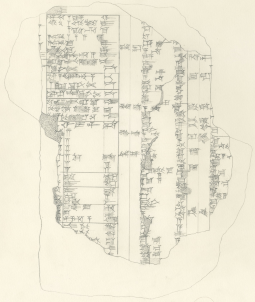A Neo-Babylonian Grammatical List, HS 1610

HS 1610 (reverse): Neo Babylonian grammatical text. Drawing by Kai Lämmerhirt. Copyright © Dr. Kai Lämmerhirt, Friedrich Schiller University, Jena.
Neo Babylonian grammatical texts translate individual Sumerian morphemes (prefixes and suffixes) into Akkadian. The translations are often very speculative and frequently hard to understand. They employ a set of technical grammatical terms. An example from HS 1610 comes from the obverse, column ii:
| 24' | ri | ku-u₂ | for you |
| 25' | ka-ta | you (accusative | |
| 26' | at₂-⸢ta⸣ | you | |
| 27' | at₂-⸢tu⸣ | you | |
| 28' | ⸢DUR KI⸣ | infix; once | |
| 29' | ul-⸢lu⸣ | at some time | |
| 30' | ul-lu-u₂ | that | |
| 31' | a-lak ⸢x⸣ | to go ... |
This section analyzes the uses of /ri/ in Sumerian grammar. Lines 24'-27' refer to the use of -ri- as an allomorph of the second person dative infix in Sumerian verbal forms (the standard form is -ra-). The Akkadian translations -kū (second person dative verbal suffix) and kâta (second person accusative independent pronoun) are possible renderings of the Sumerian dative infix (under circumstances a Sumerian dative may correspond to an Akkadian accusative). The renderings attā and attu (26'-27'), which represent variants of the second person nominative independent pronoun, however, are apparently added by association. Similarly, ullû (line 30') translates the use of -ri as a deictic suffix (that one over there), but ullu (some time) does not translate a known use of /ri/ and may well be added simply because of the similarity in form with ullû. Line 31' refers to the use of /ri/ as the plural stem of the verb "to go" (usually written re₇). Line 28' exemplifies the use of technical terminology. DUR (qablû) and KI(ištiššu) are both treated in a grammatical commentary text (CCP 6.6 see Leichty 1973). Unfortunately, the meaning of these terms remains unclear.
The reverse of the tablet includes a section that translates Akkadian deictic lexemes into what may have been more common expressions:
| 2' | an-niš ana ia-ši | hither = for me |
| 3' | ul-liš ana ul-li-i | over there = toward over there |
| 4' | ša₂ it-tal-ku | as in: "they set out (to go over there)" |
| 5' | a-nu-um-miš₂ ana ša₂-a-⸢šu₂?⸣ | thither = to him |
| 6' | a-nu-um-miš₂ šu-u₂ | thither = that one |
This is followed immediately by a section that lists technical grammatical vocabulary.
| 7' | ⸢DIRI⸣ ŠE u šu-<<x>>-u₂ | an excess form, imperfective and third person, |
| 8' | šu-us₂-ḫur-tum ri-a-tum | non-indicative ventive. |
| 9' | ra-qi₂-tum u ⸢muṭ?⸣-ṭi₅-tum | hidden; ... |
These technical terms are rare and often obscure, but several of them do occur in the first millennium bilingual literary composition "Exam at the Scribal School" (known as Examenstext A), line 16:
"Do you know the (grammatical terms) uhhurtu, atartu, gamirtu, šushurtu, qablītu, marû, hamṭu, which do not have [...], threefold [...]?"
The grammatical text HS 1610 includes some of the knowledge that the student in "Exam at the Scribal School" is quizzed about.
Entries and passages in HS 1610 are paralleled by AO 17602 and other Neo-Babylonian Grammatical Texts (NBGT), published in Materialien zum sumerischen Lexikon 4 (1956). The Jena text does not duplicate any of the previously known NBGTs.
27 Dec 2019Further reading
- Black, Jeremy A. 1991 Sumerian Grammar in Babylonian Theory. 2 ed. Studia Pohl: Series Major 12. Rome: Editrice Pontificio Istituto Biblico.
- Landsberger, Benno, Richard T. Hallock, Thorkild Jacobsen, and Adam Falkenstein. 1956 Materialien zum sumerischen Lexikon 4. Rome: Pontificium Institutum Biblicum.
- Leichty, Erle 1973 Two Late Commentaries. Archiv für Orientforschung 24, 78-86. Download from JSTOR (subscription required).
- Sjöberg, Åke W. 1961 Der Examenstext A. Zeitschrift für Assyriologie 64: 137-176. Download from De Gruyter (subscription required).
Niek Veldhuis
Niek Veldhuis, 'A Neo-Babylonian Grammatical List, HS 1610', Digital Corpus of Cuneiform Lexical Texts: Jena, The DCCLT Project, 2019 [http://oracc.museum.upenn.edu/dcclt/jena/highlights/hs1610/]
